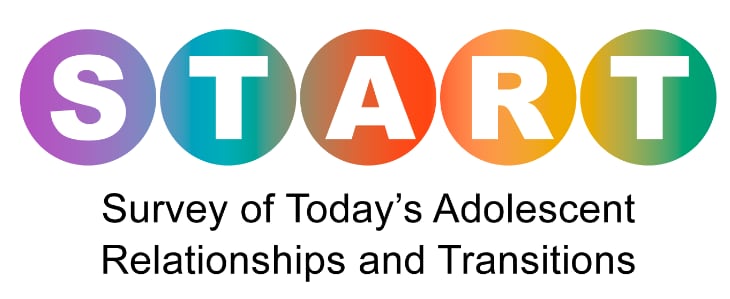Survey of Today’s Adolescent Relationships and Transitions (START)
Project Overview
To respond to the increase in HIV infection, particularly among Black and Latino adolescent sexual minority males (ASMM) and transgender youth, CDC’s Division of Adolescent and School Health (DASH), with support from the Secretary’s Minority AIDS Initiative Fund, contracted with the non-partisan and objective research organization NORC at the University of Chicago, to develop an innovative, social media-based recruitment and data collection project aimed at ASMM (13-18 years old) and transgender youth (13-24 years old).
This national project was designed to—
- increase understanding of the unique individual, interpersonal, and social characteristics of adolescent sexual minority males and transgender youth,
- provide appropriate context to HIV prevention efforts; including the preferences and behaviors of ASMM and transgender youth, especially those who identify as Black or Latino,
- inform acceptability and adherence to promising HIV prevention strategies, and
- translate these findings into HIV prevention tools and guidance for preventing HIV among ASMM and transgender youth.

Project Background
Survey of Today’s Adolescent Relationships and Transitions (START) was a four year study that began in 2016 and ended in 2020. DASH contracted with NORC to develop and test a web-based survey of sexual minority males (13-18 years old) and transgender youth (13-24 years old) with input from research experts and a youth advisory board.

The survey was implemented in spring 2018 through Instagram, Snapchat, and Facebook and resulted in over 3,000 respondents.

The Fenway Institute, under DASH direction, collected qualitative data from multiple perspectives. Adults who served youth at risk for HIV in schools, health care facilities, and community-based organizations provided information about barriers to HIV prevention in their fields. Sexual minority males and transgender youth also provided information about their experiences with accessing HIV prevention services.
Using the information from these confidential, web-based surveys and focus groups, the research team developed several tools to improve HIV prevention efforts for ASMM and transgender youth and published research papers to inform the field.
With the significant burden of HIV among adolescent sexual minority males, particularly among Black and Latino youth, understanding the factors and behaviors associated with an increased risk of HIV diagnosis is key for developing targeted prevention strategies and reducing the impact of HIV.
Project Key Findings
Below are high-level, key findings and implications from the START Project research.
- Adult stakeholders shared their strategies for meeting the health needs of ASMM and transgender youth, including:
- Creating welcoming and inclusive environments,
- Providing LGBTQ-affirming care by employing staff who are LGBTQ and/or knowledgeable about LGBTQ issues,
- Fostering open, honest, and confidential communication, and
- Leveraging referral networks, peer educators, and web resources to fill in service gaps.
- Transgender youth shared challenges to HIV/STI prevention, including:
- Diminished self-efficacy in sexual decision making,
- Concerns for personal safety when forming romantic/sexual relationships, and
- A lack of affirmative and culturally competent sexual health education and health services.
- Innovative web-technologies (e.g., video advertisements on social media platforms) proved efficient for recruiting adolescent sexual minority males and transgender youth, particularly Black and Latino youth, quickly and in a scientifically rigorous way.
- Adolescent sexual minority males and transgender youth’s knowledge of HIV prevention technologies like PrEP and nPEP was low; however,
- Older youth were more likely to have knowledge of pre-exposure prophylaxis (PrEP) and non-occupational post exposure prophylaxis (nPEP) than younger youth.
- Youth who were out to their provider were more likely to have knowledge of HIV prevention technologies than youth who were not out.
- Youth who engaged in any penetrative sex reported greater willingness to use HIV prevention technologies, like PrEP and nPEP, than youth who had not.
- Among transgender youth, those who received gender affirmation medical services were also more likely to report testing for STDs and awareness of HIV prevention technologies, such as PrEP and nPEP.
- The results of the START Project point to critical gaps in inclusive and affirming care for adolescent sexual minority males and transgender youth.
- More effort is needed to ensure that health care providers discuss gender and sexuality issues with their young patients and educate them about emerging HIV prevention technologies as they become available.
Project Tools
LGBTQ Inclusivity in Schools
This video provides a brief overview and explains how to use the self-assessment tool for school staff who are interested in supporting LGBTQ students.
- Andrzejewski J, Dunville R, Johns MM, et al. Medical gender affirmation and HIV and STD prevention in transgender youth: results from the Survey of Today’s Adolescent Relationships and Transitions, 2018. LGBT Health. 2021.
- Cahill SR, Geffen SR, Fontenot HB, et al. Youth-serving professionals’ perspectives on HIV prevention tools and strategies appropriate for adolescent gay and bisexual males and transgender youth. Journal of Pediatric Health Care. 2020;34(2),e1-e11.
- Cahill SR, Wang TM, Fontenot HB, Geffen SR, Conron KJ, Mayer KH, Johns MM, Avripas SA, Michaels S, Dunville R. Perspectives on sexual health, sexual health education, and HIV prevention from adolescent (13–18 Years) sexual minority males. Journal of Pediatric Health Care. 2021; 35(5), 500-508.
- Dunville R, Harper C, Johns M, et al. Awareness and willingness to use biomedical prevention strategies for HIV among sexual and gender minority youth: results from a national survey. Journal of Adolescent Health. 2021;68(1),199-206.
- Fontenot HB, Cahill SR, Wang T, et al. Transgender youth experiences and perspectives related to HIV preventive services. Pediatrics. 2020;145(4),e20192204.
- Stern M, Carpenter R, Fordyce E, et al. Evaluating the data quality of a national sample of young sexual and gender minorities recruited using social media. Social Science Computer Review. 2020.
- Stern M, Fordyce E, Hansen C, et al. Social media recruitment for a web survey of young sexual and gender minorities: an evaluation of methods used and resulting sample diversity. LGBT Health. 2020;7(8).
- Schlissel AC, Carpenter R, Avripas S, Heim Viox M, Johns MM, Harper C, Michaels S, Dunville R. Substance misuse and condomless sex among transgender youth. Transgender Health. 2021.

